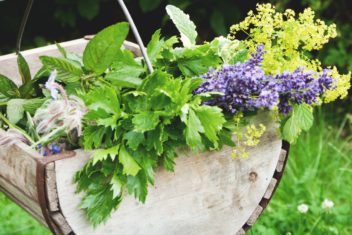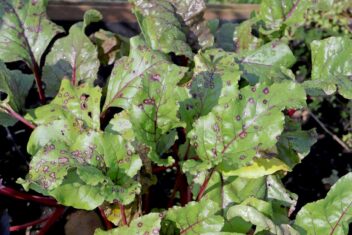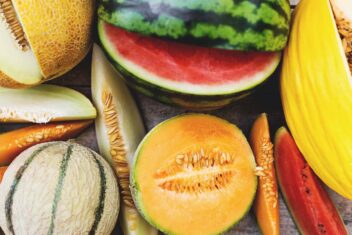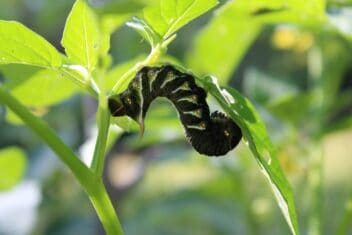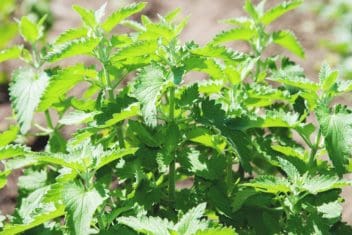Intercropping is a particularly useful element of polyculture that I think everyone should utilize, but that doesn’t mean it’s right for every situation. Like everything, intercropping has its pros and cons.
You may hear a ton of different gardening terms every day, but intercropping usually isn’t one of them. Intercropping is the practice of growing different plants together to benefit the overall garden.
So when is intercropping a good idea? And how do you make it work? Let’s dive in.

Why Use Intercropping Techniques?
First of all, what is >polyculture? It’s is a method of gardening to control pests naturally and without chemicals. Polyculture is also a strategy to help reduce weeds and diseases in a sustainable way.
It’s ideally suited to gardens where you’re providing food for your family or you want to have a chemical-free vegetable garden.
Polyculture consists of a few different methods. The end goal of each method is the same- bigger harvest, fewer pests, and disease, all while cultivating natural, healthy soil. Intercropping is one key method.
While we’ll focus on intercropping in this guide, all of the varying forms of polyculture are worth knowing because they can help you grow a productive garden without the need for as many pesticides and labor.
So why use intercropping techniques? In our homestead, it’s a way to mimic a natural ecosystem where all the plants work together and produce bigger yields.
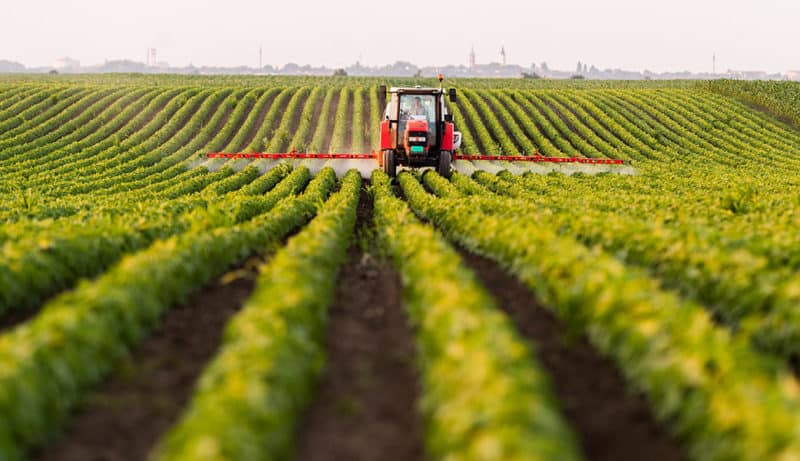
You’ll never see lines of single types of crops in polyculture like you do in monoculture, where one crop is planted on its own. But you will see groups of various plant species planted together, much like you would in nature.
The con for intercropping versus using one crop is that it makes harvesting and treating diseases a bit more challenging, particularly if you rely on machines to help you do the work. That’s why intercropping isn’t used commercially as often.
For the home gardener, however, it can be an attractive option.
Four Intercropping Techniques
I compare intercropping to well-thought-out companion planting. There are several types of intercropping techniques, all with their own pros and cons.
1. Mixed Cropping
With this method, you simply plant a variety of crops together, rather than in neat rows of single crops.

One strategy is to choose crops that attract beneficial insects that can help out both plants. For instance, if you have a plant that attracts aphids, put another plant next to it that attracts lacewings and lady beetles, which like to munch on aphids.
Another example might be planting onions and carrots together. Carrot root fly will avoid onions and onion fly avoids carrot greens. Long rows or large groups of a single crop will attract pests specifically for that crop and you’ll need to use pesticides to control them.
You could also choose crops that provide nitrogen to the soil for a plant that requires lots of nitrogen. A common example of this is when people plant tomatoes next to legumes.
An example of a mixed crop garden is:
- Pumpkins
- Corn
- Beans
- Squash
Here’s how all the plants work together. The beans climb the strong corn stalks and add nitrogen to the soil. The pumpkins and squash wind their way through the corn and beans provide shade at soil level.
2. Alley Cropping
Another of the intercropping techniques is alley cropping. With alley cropping, you plant crops in rows but each row is a different type of plant that benefits the rows around it. This suits a slightly larger garden than mixed cropping.
The onion and carrot example makes for good alley cropping given they both grow well in rows.
The disadvantage here is that you lose some of the weed-detering cover that you might get with other interplanting techqniques.
3. Temporal Intercropping
Temporal intercropping is when you plant a slow-growing crop with a fast-growing crop. This works for any size garden. One example is to plant radishes around a pumpkin. Radishes grow so fast you can plant, harvest, and replant the radish while the slower growing crop matures.
A benefit here is providing shade to the soil around the slow-growing pumpkins. Radish also repels many insects that otherwise would have nibbled on the gourds. Plant radish around:
- Beans
- Beets
- Peas
- Spinach
- Squash
- Tomatoes
- Cucumbers
The con with this intercropping technique is that if you combine two plants that don’t play well, you could end up hurting both plants. For instance, if you planted some early peas next to slow-growing onions, you could stunt the growth of your pea crop.
4. Food Forests
Permaculture is a great example of polyculture. The permaculture technique of growing a food forest is as far from planting single crops in rows as you can get. With this method, seven layers of varying types of plants all work together to create a natural forest-like environment.
Although you don’t have to have a huge area, food forests work better in larger plots of land.
What Kind of Plants Work Well for Intercropping?
Pretty much any plant can be used in intercropping, but you need to do your research first. For instance, black walnut puts out a toxin that most plants can’t stand, but mint grows happily under the trees.
You don’t just have to stick with fruits and vegetables, either.
The use of flowers and herbs in a polyculture garden enhances the efficiency of the ecosystem. How many times have you seen a vegetable garden, neatly planted in rows of vegetables, and many of them are eaten to death by insects? Or the plants have to be covered in pesticides to keep them alive?
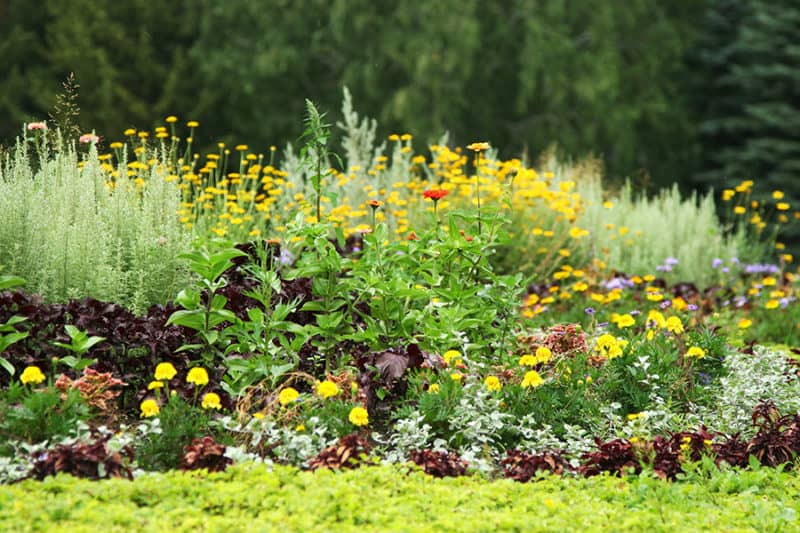
You can plant any sort of fruit or vegetable along with flowers and herbs such as:
- Marigolds – deter whiteflies, nematodes, and Mexican bean beetles.
- Borage – adds nutrients to the soil and deters tomato hornworms and cabbage worms.
- Dill – attracts beneficial wasps. Dill will attract tomato hornworms so can be used to deter them from attacking tomatoes. Plant dill among onions and cucumbers to deter aphids and spider mites.
- Bee Balm – attracts honeybees to the garden.
- Basil – Repels thrips, flies, and mosquitoes. Basil is said to make tomatoes grow larger.
Do your research before combining crops, however. One of the cons of intercropping is that you may do more harm than good if you combine plants that compete with each other.
The Pros of Intercropping
With the advent of fertilizers and pesticides, growing crops in the commercial market using monoculture became the main style of gardening, both on large and small plots.
In recent years, there has been a renaissance around techniques like intercropping as more gardeners recognize that the methods are healthier for you and the garden environment. An added bonus is that harvest volumes often increases.
As an added bonus, less time spent weeding and fertilizing means you can concentrate on other things in the garden.
Pest Control
Compared to a monoculture garden, the polyculture garden on our homestead has far fewer pests. The theory behind this is:
- Plants repel pests for the other plants in the polyculture garden
- Pests find it more difficult to hone in on their favorite crop
- Polycultures attract more beneficial insects that attack pests
Theoretically, fewer pests means larger yields and more food for you.
Disease Control
We have seen a huge decrease in diseases in the garden when we integrated intercropping techniques. This is because if a plant does get diseased, it’s less likely to spread because the other plants around it aren’t susceptible to a disease that one plant gets.
Basically, you form a barrier around an infected plant like tomatoes with plants that aren’t bothered by tomato diseases.
Also, because of the healthier environment, plants are more resistant to disease. Compare this to crops planted in rows touching each other and the surrounding soil exposed to the elements.
Weed Management
Weeds don’t usually get established well in polyculture gardens. The density of most intercropping planting allows for less available space and sunlight for weeds to grow.
Also, there are fewer nutrients available to undesirable plants due to the polyculture garden utilizing the resources more efficiently.
However, you should allow beneficial weeds to grow alongside your crops to help balance out the natural environment. These may include:
- Broadleaf plantain– adds valuable nutrients to the soil
- Chickweed – attracts beneficial insects along with pollinators in spring and summer
- White clover – adds nitrogen to the soil and attracts beneficial insects to the garden like ladybugs and pollinators.
Healthier Soil
Intercropping benefits both the gardener and the environment.
Excessive digging and tilling of soil in monoculture removes essential microbes and nutrients. Intercropping more closely mimics the natural environment and therefore preserves soil quality and reduces the money you spend on fertilizers.
Less fertilizer means less pollution. Monoculture relies on fertilizers, many of which end up in waterways, the water table, and in you.
Less digging also means you reduce soil erosion.
The Cons of Intercropping
Even when done right, intercropping can have some drawbacks, though the good has the potential to outweigh the bad.
Intercropping is a learning process and that means you may end up making costly mistakes as you figure things out.
That’s why careful planning is key to avoid some of the cons of intercropping. It’s also a good idea to reach out to your local extension office for some tips and advice.
Labor Intensive
Intercropping can take more time than traditional gardening techniques because you can’t always rely on machines to do the work.
It also takes more planning and experimentation to figure out what works in your space.
Weeding and harvesting can take longer, as well. If you do it right, you should have fewer weeds, but that doesn’t mean you won’t have to contend with any at all. The ones that do grow may be harder to spot and remove.
Reduced Harvest
While the ultimate result of intercropping could be that you’ll increase your harvests, it may take years to get there. At first, you could possibly see a reduction in yields.
Problems you may encounter are crops that end up being incompatible or that compete with each other for nutrition.
Start Slow
The best advice I have if you want to start with polyculture is to take it all in gradual steps because you will make mistakes along the way. As you learn from those mistakes, you can modify the next attempt.
If you have traditional gardens and want to try some of these intercropping techniques, dedicate one garden to one method and keep going normally with the others. Don’t switch all gardens to polyculture at the same time.

